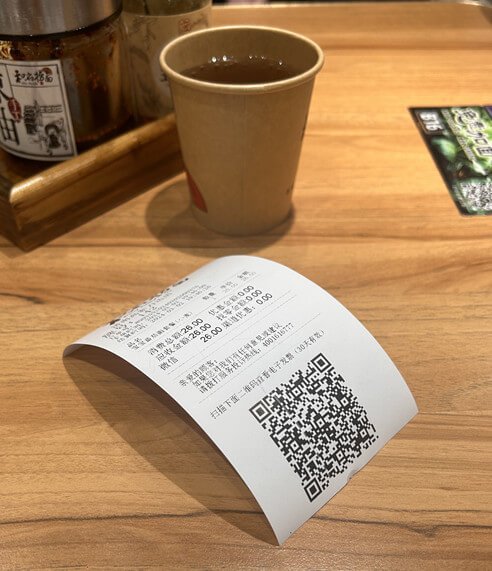Paper receipts play a crucial role in offline transactions. With QR codes, you can seamlessly integrate paper receipts into your omnichannel marketing strategy, creating new opportunities for customer engagement.
In this article, we’ll explore QR codes and how you can use them to enhance convenience for your business and your customers.
But before diving deep into the article’s meatiest part, let’s define QR code.
What is a QR code?

A QR code sample Source: Panda Paper Roll
A QR code (quick-response code) was invented in 1994 by a Japanese company. It is a square, two-dimensional barcode that stores information, akin to a digital Post-it note. It can be read by a smartphone or tablet equipped with a camera and a QR code scanner app.
But what’s the point of these QR codes, you may wonder? Well, they can hold different types of information like product information, website URLs, contact information, to name a few. You may have seen them on a business card, flyer, or magazine.
QR codes are helpful in marketing. Some restaurants, for example, may have QR codes on their menus that, when scanned, take you to their website or a page showcasing daily specials. There’s another way to maximize a QR code fully – QR receipts.
What is a QR receipt?
A QR receipt is a digital receipt that customers can access by scanning a unique QR code. This code is typically found on the physical paper receipt you give customers at checkout or sometimes on the product they purchased.
Once the customers scan the code with their smartphone or other QR-scanning device, you can direct them to a digital copy of the receipt. Some company brands will even lead customers to other links like a website or a special offer of a product.
Customers also find QR codes convenient. According to a survey, 57% of respondents scanned a food QR code to get specific information about the product, and 67% agreed that these codes make life easier.
7 Benefits of Using QR Codes on Paper Receipts
Now, imagine combining QR codes with paper receipts – the possibilities are endless. Here are just a few of the benefits:

QR code on receipt paper Source: Panda Paper Roll
1. Drive traffic to your website
Customize your QR codes to bring customers to your website with a quick scan. This can be especially beneficial for online businesses looking to drive more traffic to their website.
For example, a coffee shop could include a QR code on its receipts, leading customers to its website to purchase its unique blends and merchandise.
2. Collect reviews and ratings with the QR code
QR codes can also be used to encourage customers to leave reviews and ratings. This can provide valuable feedback for businesses and help other potential customers make informed decisions.
For instance, a restaurant could include a QR code on their receipt that takes customers to their Facebook fan page or Google review page where they can leave their honest opinions about their dining experience.
3. Encourage APP downloads
QR codes can also be used to prompt customers to download a brand’s app. This can be a great way to keep customers engaged and provide exclusive deals and offers.
A fashion retailer could include a QR code on its paper receipt that leads customers to its app to view the latest styles and receive in-app discounts.
4. Increase social media followers and engagement
QR codes can also be used to promote a brand’s social media channels. Including a QR code on a paper receipt encourages customers to follow the brand on social media and engage with their posts.
For example, a gym could include a QR code on its paper receipt, leading customers to its Instagram account to see workout videos and fitness tips.
5. Streamline customer feedback
QR codes can also be customized to allow customers to leave feedback directly on the brand’s website. This can make it easier for businesses to collect feedback and improve their products or services.
A hair salon could include a QR code on its paper receipt that takes customers to a survey page on its website where they can rate their service and provide feedback.
6. Provide product information
QR codes can also provide customers with more information about a particular product. This can be especially helpful for businesses with limited space to display product information.
A grocery store could include a QR code on its paper receipt that leads customers to a page on its website with detailed nutritional information about a particular product.
7. Enhance customer experience
Overall, QR codes on paper receipts can enhance the customer experience by providing more information and options. Using customized QR codes, you can show your customers that you care about their needs and wants.
A pet store could include a QR code on its paper receipt that leads customers to a page on its website with information about upcoming in-store events and a loyalty program.
5 Best Practices for Using QR Codes on Paper Receipts
Are you interested in using QR codes on your paper receipts? We’ve got you covered. Here’s a list of action plans to get you started.
1. Find a reliable company to print the QR codes
The best way to show QR codes to customers is to print them on the paper’s front side (thermal side) with your POS system and thermal printer. You can ask the help from your POS service supplier.

The pre-printed QR code on the receipt paper Source: Panda Paper Roll
However, there’s a better way to make things efficient – Panda Paper Roll Company can provide you with pre-printed QR codes on the back of the paper (usually the non-thermal side of the paper receipt). That way, you don’t have to worry about purchasing any additional equipment.
2. Generate QR codes
Once you’ve decided where to print the QR codes, it’s time to generate them. Luckily, many third-party services can help you with this. Some popular options include QR Code Generator – which is owned by Bitly (https://www.qr-code-generator.com/) and QR Stuff (https://www.qrstuff.com/).

You can generate anything into a QR code Source: qr-code-generator.com
All you need to do is input your desired information (such as a website URL or contact information), and the service will create a QR code for you.
You can also use a dynamic QR code. You can effortlessly update its destination or contents without the need for reprinting. This keeps your QR Code content up to date according to campaign requirements and saves on costs and distribution efforts.
3. Create scannable and readable code
You want to ensure that the QR code is large enough to be easily scanned but not so large that it takes up too much space on your receipt.
We recommend a size of at least 2cm x 2 cm (0.8 x 0.8 in) for optimal scanning.
4. Test and optimize the placement of your QR codes
It’s always a good idea to test the placement of your QR codes and find out which works best for your business. Try placing them at various places on your receipts or test different sizes to see which codes get the most scans and are most effective.
You might be surprised at how much of a difference it makes to try different strategies and tweak your tactics.
5. Ensure privacy and security of users’ data
QR codes may be used to collect customer data, which can benefit both the business and the customer. However, you must ensure that the data collected through QR codes is protected and secure.
You can do this by providing clear transparency to customers about how their data is being collected, stored, and used. Be transparent on your privacy policy and terms of use. Additionally, stay compliant with privacy and security regulations by being updated with the latest information.
Order Receipt Paper from Us Today
This is the beginning of what can be done with QR codes on paper receipts. When used strategically, these codes can become a powerful tool in helping e-commerce businesses engage and grow their customer base in an omnichannel manner. For more information on how to use QR Codes on paper receipts, contact us today. We offer custom rates on receipt solutions that could help you get started immediately. Don’t wait any longer – start reaping the rewards and ensure your business stands out from the competition now.






